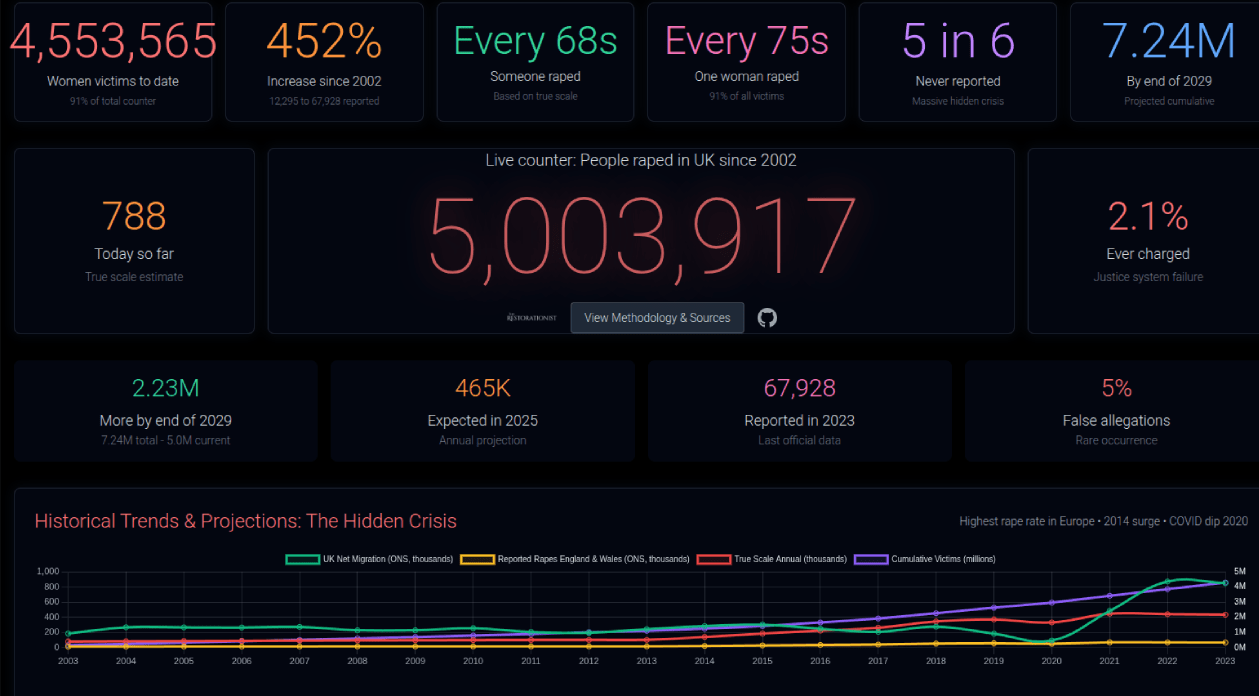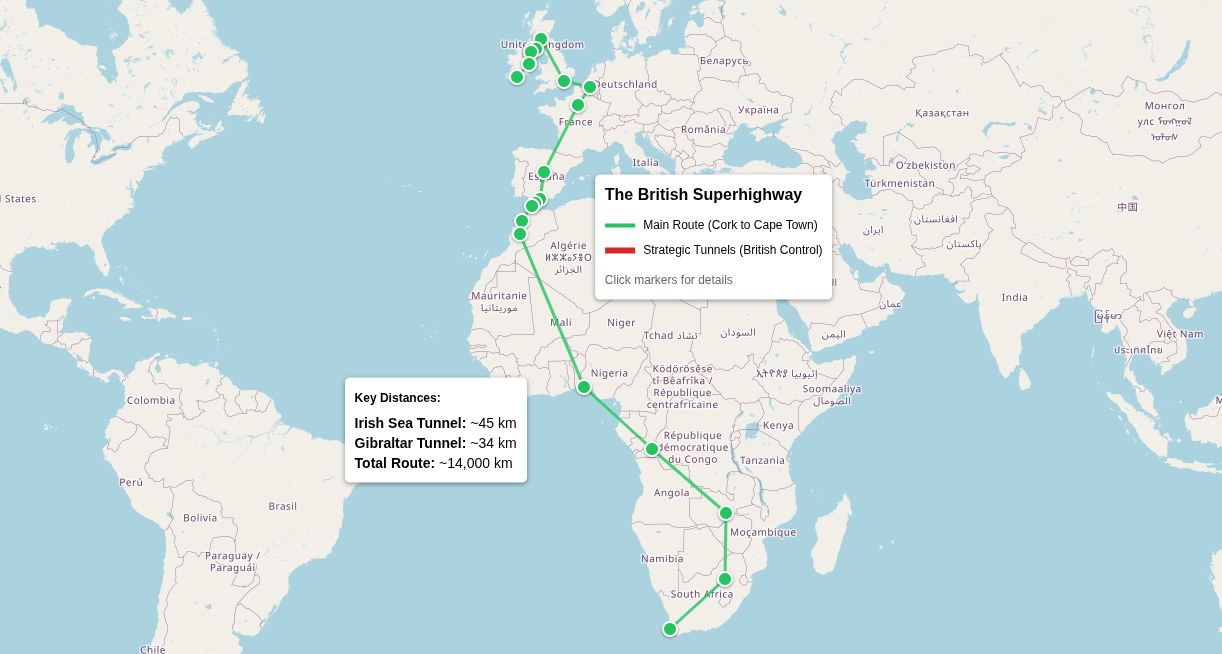Rape & Migration: 5 Million Hidden Victims In 20 Years
Over 5 million people have been raped in the UK since 2002. England has Europe's highest recorded rate, and only 2.1% of reports result in charges. 99.6% of actual rapists walk free. A hidden epidemic of unprecedented scale.

The numbers are so staggering they defy comprehension. Since 2002, according to official government statistics, an estimated 5 million people are believed to have been raped in the United Kingdom. Every 68 seconds, someone becomes a victim of sexual violence. Every 75 seconds, a woman is raped. By the end of 2029, this figure will reach 7.2 million victims if current trends continue. These are not mere statistics—they represent a hidden epidemic which has transformed Britain into the sexual violence capital of Europe while its justice system systematically fails survivors at every level.
First Things First: What The Data Says
The most recent data we have from the ONS is 2023, so we use a conservative linear gradient of 3.5% to extrapolate until 2029. Even on this moderate axis, the results are catastrophic.
- 5+ million people raped in the UK since 2002 (true scale estimate)
- Only 2.1% of reported cases result in criminal charges
- 5 out of 6 rapes are never reported to police
- England has the highest rape rate in Europe (117.7 per 100k vs EU 21.5)
- 99.6% of actual rapists are never charged with an offence
Our data cross-references well with Statista's breakdown of ONS figures, but actually pitches down to be more moderate when factoring in other variables.
Rape Crisis estimates the figure is actually a million higher than ours:
As of March 2022... 6.54 million women had been raped or sexually assaulted since the age of 16.
Deep breath in. This isn't going to be pleasant. (Hint: scroll right on the embedded table as it contains 11 columns total.). Figures extrapolated at conservative 3.5% after 2023:
| Year | E&W | UK Total | After False | True Scale Female | True Scale Male | Cumulative Reported | Cumulative True Scale | Charged (Reported) | NOT Charged (Reported) | NOT Charged (True Scale) |
|---|---|---|---|---|---|---|---|---|---|---|
| 2002 | 12295 | 13795 | 78632 | 71555 | 7077 | 13795 | 78632 | 290 | 13505 | 78342 |
| 2003 | 12500 | 14025 | 79943 | 72748 | 7195 | 27820 | 158575 | 295 | 13730 | 79648 |
| 2004 | 13000 | 14586 | 83140 | 75657 | 7483 | 42406 | 241715 | 306 | 14280 | 82834 |
| 2005 | 13500 | 15147 | 86338 | 78568 | 7770 | 57553 | 328053 | 318 | 14829 | 86020 |
| 2006 | 14000 | 15708 | 89536 | 81478 | 8058 | 73261 | 417589 | 330 | 15378 | 89206 |
| 2007 | 14500 | 16269 | 92733 | 84387 | 8346 | 89530 | 510322 | 342 | 15927 | 92391 |
| 2008 | 15000 | 16830 | 95931 | 87297 | 8634 | 106360 | 606253 | 353 | 16477 | 95578 |
| 2009 | 15200 | 17054 | 97208 | 88459 | 8749 | 123414 | 703461 | 358 | 16696 | 96850 |
| 2010 | 15500 | 17391 | 99129 | 90207 | 8922 | 140805 | 802590 | 365 | 17026 | 98764 |
| 2011 | 15800 | 17728 | 101050 | 91956 | 9095 | 158533 | 903640 | 372 | 17356 | 100678 |
| 2012 | 16000 | 17952 | 102326 | 93117 | 9209 | 176485 | 1005966 | 377 | 17575 | 101949 |
| 2013 | 16038 | 17995 | 102572 | 93341 | 9231 | 194480 | 1108538 | 378 | 17617 | 102194 |
| 2014 | 22000 | 24684 | 140699 | 128036 | 12663 | 219164 | 1249237 | 518 | 24166 | 140181 |
| 2015 | 29000 | 32538 | 185467 | 168775 | 16692 | 251702 | 1434704 | 683 | 31855 | 184784 |
| 2016 | 35000 | 39270 | 223839 | 203693 | 20146 | 290972 | 1658543 | 825 | 38445 | 223014 |
| 2017 | 41000 | 46002 | 262211 | 238612 | 23599 | 336974 | 1920754 | 966 | 45036 | 261245 |
| 2018 | 54000 | 60588 | 345352 | 314270 | 31082 | 397562 | 2266106 | 1272 | 59316 | 344080 |
| 2019 | 58000 | 65076 | 370933 | 337549 | 33384 | 462638 | 2637039 | 1367 | 63709 | 369566 |
| 2020 | 52000 | 58344 | 332561 | 302631 | 29930 | 520982 | 2969600 | 1225 | 57119 | 331336 |
| 2021 | 69973 | 78488 | 447382 | 407118 | 40264 | 599470 | 3416982 | 1648 | 76840 | 445734 |
| 2022 | 68949 | 77340 | 440838 | 401163 | 39675 | 676810 | 3857820 | 1624 | 75716 | 439214 |
| 2023 | 67928 | 76195 | 434312 | 395224 | 39088 | 753005 | 4292132 | 1600 | 74595 | 432712 |
| 2024 | 70305 | 78882 | 449627 | 409161 | 40466 | 831887 | 4741759 | 1657 | 77225 | 447970 |
| 2025 | 72766 | 81643 | 465365 | 423482 | 41883 | 913530 | 5207124 | 1715 | 79928 | 463650 |
| 2026 | 75313 | 84501 | 481656 | 438307 | 43349 | 998031 | 5688780 | 1775 | 82726 | 479881 |
| 2027 | 77949 | 87459 | 498516 | 453650 | 44866 | 1085490 | 6187296 | 1837 | 85622 | 496679 |
| 2028 | 80677 | 90520 | 515964 | 469527 | 46437 | 1176010 | 6703260 | 1901 | 88619 | 514063 |
| 2029 | 83501 | 93688 | 534022 | 485960 | 48062 | 1269698 | 7237282 | 1967 | 91721 | 532055 |
Now, if we plot that against official legal net migration figures (not including illegal migrants), it gets far more stark and alarming on a scale which is hard to fathom. The curves are disturbingly similar.
Figures given in thousands, extrapolated at conservative 3.5% after 2023:
| Year | Net MIgration (ONS) | Reported E&W (ONS) | True Scale Annual | Victims (millions) |
|---|---|---|---|---|
| 2003 | 185 | 12.5 | 79.9 | 0.16 |
| 2004 | 268 | 13.0 | 83.1 | 0.24 |
| 2005 | 267 | 13.5 | 86.3 | 0.33 |
| 2006 | 265 | 14.0 | 89.5 | 0.42 |
| 2007 | 273 | 14.5 | 92.7 | 0.51 |
| 2008 | 229 | 15.0 | 95.9 | 0.61 |
| 2009 | 229 | 15.2 | 97.2 | 0.70 |
| 2010 | 256 | 15.5 | 99.1 | 0.80 |
| 2011 | 205 | 15.8 | 101.0 | 0.90 |
| 2012 | 195 | 16.0 | 102.3 | 1.01 |
| 2013 | 244 | 16.0 | 102.6 | 1.11 |
| 2014 | 284 | 22.0 | 140.7 | 1.25 |
| 2015 | 303 | 29.0 | 185.4 | 1.43 |
| 2016 | 249 | 35.0 | 223.8 | 1.66 |
| 2017 | 208 | 41.0 | 262.1 | 1.92 |
| 2018 | 276 | 54.0 | 345.4 | 2.27 |
| 2019 | 184 | 58.0 | 370.9 | 2.64 |
| 2020 | 93 | 52.0 | 332.6 | 2.97 |
| 2021 | 484 | 70.0 | 447.5 | 3.42 |
| 2022 | 873 | 68.9 | 440.9 | 3.86 |
| 2023 | 850 | 67.9 | 434.4 | 4.29 |
The Rape Capital Of Europe

England and Wales recorded 117.7 rape offences per 100,000 population in 2021, making it the highest rate in Europe by a devastating margin. This figure is 23% higher than Sweden, the second-highest country at 96.0 per 100,000, and represents a staggering 447% above the European average of 21.5 per 100,000. The scale of this crisis positions the United Kingdom not as an unfortunate outlier, but as a nation where sexual violence has reached epidemic proportions which dwarf every other European country.
The official statistics paint only the visible edge of this crisis. In 2023, police in England and Wales recorded 67,928 rape offences, representing a 452% increase from the 12,295 cases recorded in 2002. This dramatic rise cannot be explained by population growth alone, which increased by just 13% over the same period. Instead, it reveals a crisis which has accelerated far beyond demographic changes, suggesting either a genuine explosion in sexual violence or a belated recognition of crimes that were previously hidden in shadows of silence and shame.
The Mathematics of Hidden Suffering
The true scale of this epidemic only emerges when accounting for the massive underreporting that characterizes sexual violence. Rape Crisis England & Wales and the Victims Commissioner both estimate only one in six rapes are ever reported to police, meaning the recorded figures represent merely the visible fraction of a much larger catastrophe. When this underreporting rate is applied to official statistics, using conservative academic estimates which account for false allegations, the numbers become almost incomprehensible.
The methodology behind these calculations follows a rigorous approach that begins with official police recorded crime data from the Office for National Statistics. These England and Wales figures are scaled up by 12.2% to account for Scotland and Northern Ireland populations, creating UK-wide totals. The underreporting multiplier of six reflects extensive victim surveys that consistently show five out of six rapes never reach police attention. A 5% adjustment accounts for false allegations, using the conservative middle estimate from academic research that places false reporting between 2-8% of cases.
This calculation reveals that while 67,928 rapes were recorded in England and Wales during 2023, the true scale across the UK likely reached 434,312 victims. The cumulative impact since 2002 suggests over 4.3 million people had been raped by the end of 2023, with projections indicating this will exceed 5 million by late 2025 and reach 7.2 million by 2029 if current trends continue unchanged.
The Striking Correlation With Migration
Blue is net migration. Red is reported rapes. Green is the true scale (reported + unreported). Purple is the cumulative rolling aggregate.

The relationship between rape statistics and net migration data reveals disturbing patterns which illuminate the interconnected nature of sex-based violence in the UK. A forensic examination of both datasets from 2003 to 2023 shows not merely parallel trends but a complex interplay suggesting common underlying drivers and shared institutional failures in response.
This is no joke. The numbers of migrants charged or convicted of rapes and sexual assaults has been skyrocketing:
- Asylum seeker ‘sexually assaulted girl’ days after boat crossing
- Asylum seeker blames rape of teenage girl on ‘cultural differences’
- Migrant jailed for 10 years over rape of 15-year-old girl
- Illegal immigrant Hamidullah Hamidi jailed for rape of girl, 14
- Hundreds of migrants living in taxpayer-funded hotels across the UK accused of offences including rape, sex attacks, robbery, theft and violence
- 'Channel migrant' charged with raping woman '40 days after landing in UK'
- Rape charge against asylum seeker in migrant hotel 'covered-up' to avoid inflaming 'community tension'
- Hundreds of migrants in UK hotels have been charged with rape, robbery and GBH
- Syrian migrant raped 15-year-old girl who had run away from home
- UK Court Blocks Deportation of Migrant Who Raped Sleeping Woman
- Asylum seeker raped 15-year-old girl after his deportation flight was blocked by protesting cabin crew
- Migrant in taxpayer-funded hotel who sexually assaulted woman, 19, with special needs in broad daylight jailed
- Foreigners convicted of nearly a quarter of sex crimes
- Asylum seeker who came to Britain on small boat is jailed for raping woman after she left nightclub
- Failed asylum seeker who raped teenage girl has admitted three more serious sex offences
Unfortunately, we do not hold statistics on those charged with murder, attempted murder, rape and attempted rape on UK citizens.
Net migration began its measurement period in 2003 at 185,000 cases, following a relatively stable trajectory through 2008 with numbers fluctuating between 195,000 and 284,000 annually. This initial period of stability contrasts sharply with rape statistics, which maintained steady but low reporting levels around 12,000-16,000 cases. The divergent patterns during 2003-2013 suggest they were initially perceived and responded to as distinct phenomena by both victims and authorities.
The correlation between them became dramatically apparent from 2014 onwards, precisely coinciding with the sharp acceleration in rape reporting. While rape cases surged from 22,000 in 2014 to peak levels exceeding 67,000 by 2023, net migration followed its own alarming trajectory. Migration numbers reached 303,000 in 2015, representing a 64% increase from the 2003 baseline, but then exhibited concerning volatility.
The most revealing correlation emerges in the 2020 COVID-19 period, when both showed synchronised responses to lockdown conditions. Net migration plummeted to just 93,000 in 2020, while rape cases fell to 52,000.
The post-lockdown rebound proves equally illuminating. Net migration exploded to 484,000 in 2021 and reached an unprecedented 873,000 by 2022, representing a 372% increase from 2020 levels and a 271% increase from the 2015 peak. Simultaneously, rape cases rebounded to 70,000 in 2021 and stabilised around 68,000-69,000 through 2023.
The mathematical relationship between these trends reveals striking proportional consistency. In 2015, when both showed elevated reporting, the ratio stood at approximately 4.5 net migration cases for every rape case (303,000 vs 29,000). By 2022, despite the massive absolute increases in both categories, this ratio had expanded to 12.7 per rape case (873,000 vs 68,949).
The synchronised reporting patterns suggest these crimes often affect overlapping populations, with many survivors experiencing multiple forms of violence which create compound reporting barriers and trauma responses.
The forensic analysis reveals 2020 represents a watershed moment for understanding both. The synchronised collapse and rebound patterns indicate these statistics measure not just crime occurrence but system functionality, victim confidence in reporting, and institutional capacity to respond. The fact net migration reached unprecedented levels in 2022 while rape reporting returned to pre-pandemic patterns suggests different recovery trajectories which may reflect varying policy responses and social recognition.
The trajectory correlation ultimately suggests rape and net migration represent interconnected manifestations of broader systemic failures in preventing and responding to gender-based violence. The synchronised patterns indicate common underlying drivers including social attitudes toward women, institutional response capacity, and victim confidence in seeking help. Understanding these as isolated phenomena rather than interconnected aspects of a broader crisis has likely contributed to the inadequate scale of response to both.
Women And Children
Women bear the overwhelming burden of this crisis, comprising 91% of all rape victims according to the ONS Crime Survey for England and Wales. This means of the estimated 5 million total victims since 2002, approximately 4.55 million are women and girls. The consistency of this sex-based breakdown across age groups and time periods underscores sexual violence in Britain is fundamentally a crisis of violence against women, though the 450,000 male victims represent a significant population whose suffering often remains invisible in public discussion.
A woman cannot be charged with the offence of rape under Section 1 of the Sexual Offences Act 2003 unless she is acting as an accomplice to a male who commits the act of penile penetration. However, a woman can still be charged with other serious sexual offences, including:
- Assault by penetration (Section 2) – involving penetration with a body part or object, without consent.
- Causing a person to engage in sexual activity without consent (Section 4) – which includes forcing a man to penetrate her, either with his penis or otherwise.
- Persuading or forcing a boy under 16 (or under 13) to have sex even if he appears willing (Sections 10 & 8).
The timing statistics are equally stark. Based on 2025 projections of 465,365 annual victims, someone in the UK becomes a rape victim every 68 seconds. For women specifically, this interval narrows to every 75 seconds, creating a relentless rhythm of violence which continues around the clock, every day of the year. These figures suggest during the time it takes to read this article, 12 people will have been raped across the United Kingdom.
Breathtaking Lack Of Prosecution
Perhaps the most damning aspect of this crisis is the systematic failure of the justice system to respond adequately to sexual violence. According to the House of Lords Library analysis of rape prosecution statistics, only 2.1% of reported cases result in criminal charges. This represents a catastrophic decline from historical charging rates and effectively means that 98% of reported rapes never progress to prosecution, let alone conviction.
When this charging rate is applied to the true scale of sexual violence rather than merely reported cases, the mathematics of impunity become staggering. Since 2002, approximately 17,500 people have been charged with rape across the UK. Against a true scale of 5 million victims, this means 99.6% of actual rapists have never faced criminal charges. The justice system is not merely failing rape survivors—it has effectively decriminalized sexual violence through systematic inaction.
This collapse in criminal justice response cannot be explained by resource constraints alone. The dramatic increase in reported cases from 2014 onwards, which saw annual figures rise from 22,000 to over 67,000 in England and Wales, coincided with falling charging rates rather than expanded capacity to handle the caseload. The system appears to have been overwhelmed by the scale of sexual violence while simultaneously reducing its response effectiveness, creating a perfect storm of injustice that has allowed the crisis to accelerate unchecked.
Historical Trajectory and Future Projections
The data reveals a crisis which has intensified dramatically over two decades, with particularly sharp acceleration from 2014 onwards. The 2020 COVID-19 pandemic temporarily reduced reported cases to 52,000 as lockdowns disrupted normal social patterns, but numbers rebounded to record levels by 2021. This temporary dip in reported cases during lockdowns paradoxically suggests much sexual violence involves known perpetrators rather than stranger attacks, as domestic and acquaintance rape continued despite movement restrictions.
Growth projections based on historical trends suggest this crisis will continue expanding unless fundamental interventions occur. Using a conservative 3.5% annual growth rate derived from long-term trend analysis (see methodology), the true scale of sexual violence is projected to reach 534,022 annual victims by 2029, representing a cumulative total of 7.24 million people raped since 2002. This projection assumes no major policy interventions or societal changes that might alter current trajectories.
The regional dimensions of this crisis remain partially obscured by data limitations. While England and Wales provides comprehensive statistics, Scotland and Northern Ireland data suggests similar patterns but with lower per-capita rates. Scotland recorded 2,459 rape offences in 2022/23 compared to 924 in 2002/03, representing a 166% increase that is substantial but lower than the 471% increase seen in England and Wales over a similar period. This suggests while the crisis affects the entire United Kingdom, its intensity varies significantly by jurisdiction.
The Hidden Nature of the Crisis
The vast scale of unreported sexual violence means this crisis occurs largely outside public awareness or official recognition. Unlike other serious crimes which generate immediate police response and public attention, sexual violence predominantly happens in private settings involving known perpetrators, with victims often facing barriers to reporting that include trauma, shame, fear of not being believed, and justified skepticism about justice system effectiveness.
This hidden nature has allowed the crisis to expand exponentially while remaining largely invisible to policymakers and the public. The dramatic increases in reported cases since 2014 possibly reflect not a sudden explosion in sexual violence but rather improved awareness and reporting mechanisms which have begun to reveal the true scale of crimes that were always occurring but remained hidden from official statistics. However, given the climate of fear around stigmatisation of being seen as "racist," the variable factors are likely to be less than expected.
The implications of this hidden crisis extend far beyond criminal justice statistics. Five million survivors represent a significant portion of the UK population living with trauma which often goes unrecognised and untreated. The economic costs of this trauma, including healthcare expenses, lost productivity, and social services, likely reach billions of pounds annually but remain largely uncalculated because the scale of the crisis itself has been completely ignored.
Methodology and Data Quality
The calculations underlying these estimates follow established methodologies used by academics and advocacy organisations to estimate the true scale of sexual violence. The foundation lies in official police recorded crime data from the Office for National Statistics, which provides the most reliable baseline for England and Wales. The 12.2% adjustment to account for Scotland and Northern Ireland populations uses census data and available crime statistics from those jurisdictions, though this represents the least certain element of the calculation due to limited comparable data.
The underreporting multiplier of six derives from extensive victimisation surveys and academic research which consistently shows only approximately 16-17% of rapes are reported to police. This figure has remained remarkably consistent across different surveys and time periods, providing confidence in its application. The 5% false allegation adjustment uses the middle estimate from academic research from European studies, which places false reporting rates between 2-8% of cases, ensuring the calculations err on the conservative side.
The sex breakdown of 91% female and 9% male victims comes from the ONS Crime Survey for England and Wales, which provides the most comprehensive victimization data available. This proportion has remained consistent across survey years and age groups, suggesting it represents a stable characteristic of sexual violence in the UK rather than a temporary statistical artifact.
Projections through 2029 use conservative growth rate assumptions based on historical trend analysis. The 3.5% annual growth rate represents a significant moderation from the 8.48% compound annual growth rate calculated from 2002-2023 data, reflecting assumptions that reporting rates may stabilise and policy interventions may begin to have impact. Even these conservative projections produce alarming results, suggesting the crisis will continue expanding unless fundamental changes occur.
The Scale of Impunity
The justice system statistics reveal a level of impunity which effectively amounts to decriminalization of sexual violence. With only 2.1% of reported cases resulting in charges, and charges applying to perhaps 0.4% of actual rapes when unreported cases are considered, the mathematical probability of facing consequences for rape in the UK has become negligible. This creates a system where sexual violence is both widespread and essentially consequence-free for perpetrators.
This impunity extends beyond individual cases to create systemic effects which may contribute to the crisis's expansion. When potential perpetrators observe sexual violence rarely results in prosecution, and survivors see reporting rarely leads to justice, the incentive structures around sexual violence become fundamentally distorted. The system effectively signals rape is tolerated while discouraging survivors from seeking help or justice.
The 17,500 total charges filed since 2002 across the entire UK represent fewer than 600 charges per year on average for a crime which affects hundreds of thousands of people annually. This ratio suggests a justice system that has been overwhelmed to the point of functional collapse when addressing sexual violence, creating a feedback loop where reduced response effectiveness encourages further expansion of the crisis.
We Cannot Carry On Like This
The data presented here reveals a crisis of unprecedented scale which challenges fundamental assumptions about safety, justice, and social functioning in modern Britain. Five million rape victims since 2002 represents approximately 7.5% of the current UK population, suggesting sexual violence has affected one in every thirteen people in the country. When including family members, friends, and communities impacted by each case, the secondary effects of this crisis likely touch a significant majority of the population.
The trajectory toward 7.2 million total victims by 2029 assumes no major interventions or societal changes that might alter current patterns. This projection serves not as an inevitable future but as a warning of what will occur if current systems and responses continue unchanged. The scale of intervention required to address a crisis of this magnitude extends far beyond traditional criminal justice responses to encompass prevention education, cultural change, institutional reform, and comprehensive support for the millions of existing survivors.
The hidden nature of this crisis means most of its effects remain invisible to public policy and resource allocation. Healthcare systems, educational institutions, workplaces, and communities across the UK are dealing with the consequences of mass trauma without recognizing its scale or source. The economic and social costs of five million rape survivors living with largely untreated trauma represent a hidden burden on British society which has never been properly calculated or addressed.
This analysis reveals not merely a crime wave or justice system failure, but a fundamental crisis of safety and social functioning which affects millions of people while remaining largely hidden from public awareness. The numbers demand recognition not just as statistics but as representing the largest hidden epidemic in modern British history—one which has transformed the landscape of personal safety while the institutions responsible for prevention and response have systematically failed to meet the challenge. Only by acknowledging the true scale of this crisis can Britain begin to develop responses commensurate with its devastating impact on millions of lives.







